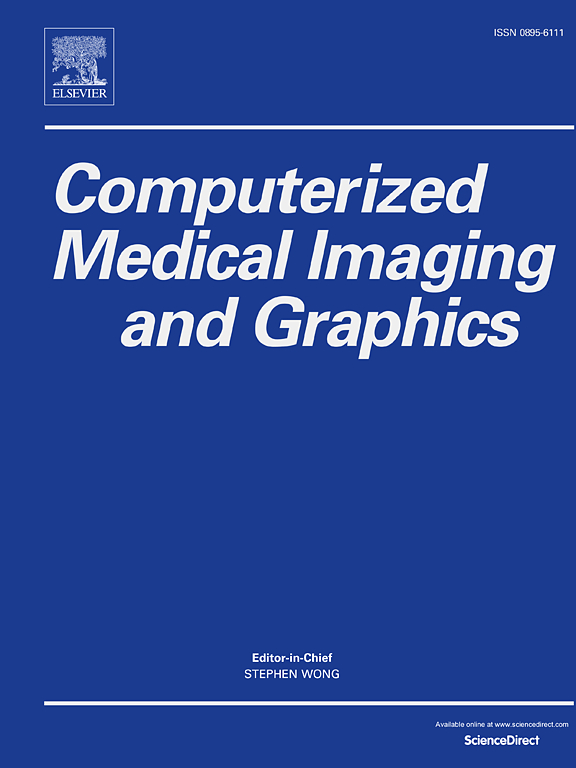AFSegNet:通过分层特征提炼和多尺度关注与融合进行少量三维踝足骨骼分割
IF 5.4
2区 医学
Q1 ENGINEERING, BIOMEDICAL
Computerized Medical Imaging and Graphics
Pub Date : 2024-11-01
DOI:10.1016/j.compmedimag.2024.102456
引用次数: 0
摘要
从 CT 扫描中准确分割踝骨和足骨对形态分析至关重要。由于骨骼边界模糊、骨骼间隙狭窄、皮质外壳存在间隙以及海绵状骨骼纹理不均匀,踝骨和足骨的分割面临挑战。我们的研究致力于创建一个深度学习框架,利用三维深度学习的优势,解决从临床 CT 扫描中准确分割踝骨和足骨的难题。考虑到计算成本,本研究提出了一个由三个三维深度学习网络组成的 "几镜式 "框架 AFSegNet,该框架遵循任务和网络结构由简到繁的原则。具体来说,一个浅层网络首先对前景进行过度分割,并与前景地面实况一起用于监督后续网络检测过度分割的区域,这些区域绝大多数是骨间间隙。然后,将前景和骨间间隙概率图输入一个多尺度关注和特征融合网络,该损失函数结合了基于区域、边界和拓扑的术语,以获得精细的骨骼分割。AFSegNet 利用 123 张内部 CT 扫描图像完成了 16 级骨骼分割任务,由于三个子网络可以连续单独训练,因此只需要配备 24 GB 内存的 GPU。AFSegNet 的 Dice 值为 0.953,平均表面距离为 0.207。消融研究以及与两个最先进的基本网络的比较表明,逐步提炼的特征、注意力和特征融合模块以及混合损失函数非常有效,平均表面距离误差降低了 50%。本文章由计算机程序翻译,如有差异,请以英文原文为准。
AFSegNet: few-shot 3D ankle-foot bone segmentation via hierarchical feature distillation and multi-scale attention and fusion
Accurate segmentation of ankle and foot bones from CT scans is essential for morphological analysis. Ankle and foot bone segmentation challenges due to the blurred bone boundaries, narrow inter-bone gaps, gaps in the cortical shell, and uneven spongy bone textures. Our study endeavors to create a deep learning framework that harnesses advantages of 3D deep learning and tackles the hurdles in accurately segmenting ankle and foot bones from clinical CT scans. A few-shot framework AFSegNet is proposed considering the computational cost, which comprises three 3D deep-learning networks adhering to the principles of progressing from simple to complex tasks and network structures. Specifically, a shallow network first over-segments the foreground, and along with the foreground ground truth are used to supervise a subsequent network to detect the over-segmented regions, which are overwhelmingly inter-bone gaps. The foreground and inter-bone gap probability map are then input into a network with multi-scale attentions and feature fusion, a loss function combining region-, boundary-, and topology-based terms to get the fine-level bone segmentation. AFSegNet is applied to the 16-class segmentation task utilizing 123 in-house CT scans, which only requires a GPU with 24 GB memory since the three sub-networks can be successively and individually trained. AFSegNet achieves a Dice of 0.953 and average surface distance of 0.207. The ablation study and comparison with two basic state-of-the-art networks indicates the effectiveness of the progressively distilled features, attention and feature fusion modules, and hybrid loss functions, with the mean surface distance error decreased up to 50 %.
求助全文
通过发布文献求助,成功后即可免费获取论文全文。
去求助
来源期刊
CiteScore
10.70
自引率
3.50%
发文量
71
审稿时长
26 days
期刊介绍:
The purpose of the journal Computerized Medical Imaging and Graphics is to act as a source for the exchange of research results concerning algorithmic advances, development, and application of digital imaging in disease detection, diagnosis, intervention, prevention, precision medicine, and population health. Included in the journal will be articles on novel computerized imaging or visualization techniques, including artificial intelligence and machine learning, augmented reality for surgical planning and guidance, big biomedical data visualization, computer-aided diagnosis, computerized-robotic surgery, image-guided therapy, imaging scanning and reconstruction, mobile and tele-imaging, radiomics, and imaging integration and modeling with other information relevant to digital health. The types of biomedical imaging include: magnetic resonance, computed tomography, ultrasound, nuclear medicine, X-ray, microwave, optical and multi-photon microscopy, video and sensory imaging, and the convergence of biomedical images with other non-imaging datasets.

 求助内容:
求助内容: 应助结果提醒方式:
应助结果提醒方式:


